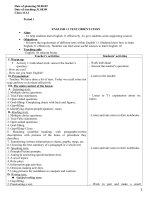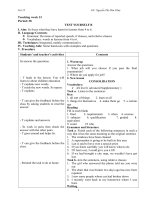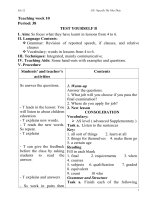unit 3 GIÁO ÁN MÔN TIẾNG ANH LỚP 12
Bạn đang xem bản rút gọn của tài liệu. Xem và tải ngay bản đầy đủ của tài liệu tại đây (197.49 KB, 13 trang )
GA 12
Week:5
Period: 14
GV: Nguyễn Thị Như Thủy
UNIT 3
WAYS OF SOCIALIZING
Lesson 1: READING
I. Aim: By the end of the lesson, students will be able to:
- Guess the meaning in context.
- understand the passage about ways of socializing.
II. Language Contents:
Grammar: reported speech, statement, questions
Vocabulary: apologize, approach, attract, clap, install…..
III. Techniques: Intergrated, mainly communicative.
IV. Teaching Aids: Some hand-outs with the questions.
V. Procedure
Students’ and teacher’s
activities
Contents
1. Warm-up:
* Match the verbs in A with its object in B
A
B
to attract
one’s hand
to raise
one’s attention
to clap / to get
2. Before you read
- Teacher leads in the lesson: 1. What are the people in the pictures doing?
Today, we will talk about 2. What will you do and/ or say if ?
- You want to get your teacher’s attention in
ways of socializing
class?
- You need to ask someone a question, but they
- Ss open the books page 30,
are busy talking to someone else?
31 and look at the picture.
Ss close the books.
- Ss work in groups
- Ss’ answers may vary.
A. READING
- Ss work in groups, answering
*Vocabulary and structures:
the questions:
Verbal communication: communicate by
language
- T walks around and helps
Assistance: helping
students.
to point: look to / towards
3. While you read
- Ss’ answer may vary.
Task 1. Give the Vietnamese equivalents to the
following words / phrases
- T: Now we’ll study the 1. verbal / non – verbal communication
1
Me too.
GA 12
reading text about ways of
socializing
- T reads the text and explains
new words and phrases. (T
uses pictures & explanations)
- T reads each word & Ss
repeat.
- Ss read after the tape to
practise pronouncing the new
words.
- Ss work in pairs, reading the
text again to get the
information of the reading.
- T explains Task 1. - Ss work
in groups.
- T walks around & helps Ss.
- T can give the feedback
before the class by asking Ss to
answer A,B or C
- T explains Task 3: Now you
answer the questions in Task 2
- Ss work in pairs, asking and
answering the questions.
- Ss check the answers
together.
- T goes around & helps Ss.
GV: Nguyễn Thị Như Thủy
2. attract someone’s attention: thu hut su chu y cua
ai
3. impolite # polite
4. rude: impolite
5. informality: than mat
6. approach: come near
7. a slight nod will do: 1 cai gat dau nhe
Task 2: Decide which of the three option below is
the best title for the passage
@ Attracting Attention: Non verbal Cues
Task 3. Answer the following questions.
1. When we want to attract someone’s attention, we
can use either verbal or non verbal
communication
2. Jumping up and down and wave as hard as you
can / is considered to be big, obvious non verbal
signals
3. If you want to attract the waiter’s attention, we
can wait until he passes near us, catch his eye,
and nod slightly to let him know we would like
him to come to our table. Or we can raise our
hand slightly to show that we need assistance.
4. If you are walking across the schoolyard and see
your teacher approaching you, you can use a
small friendly wave to attract his or her attention
5. Because pointing at someone is usually
considered rude
4. After you read
Suggested questions:
1. When do you clap your hand?
2. What do you signal when you want someone to
approach?
- T can give the feedback
before the class by asking Ss to
ask and answer the questions.
- T suggests Ss’ homework.
5. Homework:
- Learn by heart new words
- Prepare speaking
* COMMENTS:
2
GA 12
GV: Nguyễn Thị Như Thủy
Week:5
Period: 15
UNIT 3
WAYS OF SOCIALIZING
Lesson 2: Speaking
I. Aim: by the end of the lesson, students will be able to :
– practise giving compliments in different situations.
– know how to respond to compliments
II. Language Contents:
Grammar: reported speech, statement, questions
Vocabulary: words to express compliments
III. Techniques: Intergrated, mainly communicative.
IV. Teaching Aids: Some hand-outs with the questions.
V. Procedure
Students’ and teacher’s
activities
Contents
1. Warm-up
Ss close the books.
- Ss work in groups, talking Tell class about the compliments
about what they’ve learnt
- T calls some representatives
Unit 2: SPEAKING
to tell about the gesture
Talking about giving and receiving the
- T leads in the lesson: Today compliments
we’ll practise talking about 2. Before you speak
Task 1 Practise reading these dialogues, paying
some compliments
attention to how people give and respond to
complimentsin neach situation
- Ss open the books.
- T explains Task1: Discuss in *Vocabulary and structures:
Decent: polite / kind
groups about:
kidding: joking
* How people give and
compliment: khen ngoi
respond to compliments
to influence: affect
- Ss work in groups then
Exclamatory sentences
exchange together.
What + a / an adj. noun + S + V…..!
- T goes around & helps Ss.
How + adjective + S + V..!
3. While you sp eak
- Ss’answers may vary.
- T can give the feedback Task 2. Practise giving compliments to suit the
before the class by asking Ss to responses. Use the cues below
1. David: What a beautiful dress you are
answer the questions.
3
Me too.
GA 12
- T asks Ss to practise the
exchanges in task fluently.
- T explains Task 2,3 : In
pairs, you practise giving the
compliments
- T can give suggested models:
- Ss work in pairs, giving and
receiving.
- T goes around & helps Ss.
- T calls one or two pairs of Ss
to practise the conversation
before the class .
- Ss work in pairs.
- T goes around & helps Ss.
- T calls some students to tell
their likes (T can give marks)
- T suggests Ss’homework.
GV: Nguyễn Thị Như Thủy
wearing, Kathy
2. Hung: You have a decent motorbike, Hien
3. Michael: You played badminton very well
today, Colin
Task 3: Pratise responding to the compliments
below.
1. Thanks Phil I think that’s because I have
practiced a lot with the help my dancing
teacher
2. I’m glad you like listening to me playing the
guitar, Peter
3. That’s kind of you to say so, Tom. Actually,
my English is influeced by an American
teacher
4. After you speak
Make dialogues to practise giving responding to
compliments. Using the cues below
Lan: The pair of glasses you are wearing are so
nice, Phuong
Phuong: Thanks, Lan. My friend gave them to
me on my birthday.
Tam: What a new and expensive watch you
have, Nam!
Nam: I’m glad you like it. I bought it yesterday.
5. homework:
- Prepare listening
* COMMENTS:
…………………………………………………………………………………………………………………………………………………………………………………………………………………………
……………………………………………………………………………………………………………………………………………………………….
4
GA 12
Week:6
Period: 16-17
GV: Nguyễn Thị Như Thủy
UNIT 3:
WAYS OF SOCIALIZING
Lesson 3: Listening
I. Aim: By the end of the lesson, students will be able to:
- listen for general information
- listen for specific ideas
II. Language Contents:
Grammar: reported speech, statement, questions
Vocabulary: Words related to the daily life
III. Techniques: Intergrated, mainly communicative.
IV. Teaching Aids: Cassette, tape and some hand-outs with the questions.
V. Procedure
Students’ and teacher’s
activities
Ss work in groups,
- T can give the feedback
before the class by asking a
student to read the answers.
- T: Today, we’ll listen to use
the telephone / rules about
using telephone in family
Contents
1. Warm-up
Give the words that are necessary for your daily
life
- lights, food, water, TV , telephone
2. Before you listen.
Look at the picture in text book and answer the
following questions:
1. The boy is making a phone call from a
telephone box. The girl is at home when the boy
calls
2. They would say “hello” to greet each other
3. They may talk about some hot news. The boy
can check some information from the girl or give
out an invitation
*Vocabulary and structures:
marvelous: fantastic
regulation: rule
starling: giat minh
to object:
- Ss open the books.
- T explains task1. Now you
complete the sentences with
the words and phrases in the
box. You try to guess the new
words.
- Ss work in pairs.
3. While you listen
- T goes around & helps Ss.
Task 1: Listen to her talk and decide whether the
- T gives the feedback by statements are true or false
asking Ss to read the 1. T 2. F. 3. T 4. F (dinner’s over) 5. F ( a
5
GA 12
sentences aloud before class.
- T explains new words.
- T explains Task 2. You will
listen to then fill in the blanks
- Ss read the sentences in
Task 1 carefully.
- Ss listen to the tape twice or
three times and fill in.
- Ss check their answer
sentences.(T can give marks)
.
- T replays the tape twice.
- Ss work individually,
answering the questions then
check the answers together.
- T gives the feedback by
asking Ss to ask and answer
the questions before class.
- Ss work in pairs, talking
about a Vietnamese wedding
- T goes around and helps Ss.
- T calls one or two student to
repeat each question and the
answer. (T can give marks)
- Remind ss to do exercise
GV: Nguyễn Thị Như Thủy
serious) 6 T
Task 2 Listen to part of Ms. Linda Cupple’s talk
again and write the missing words
1. agreed 2. to avoid 3. particular
4. adults
5. walking
6. hear
7. kindness
8. to stick
* Tapescript
The telephone – Potential Family Battleground
Hello, everyone. In today’s talk I’m going to give
you some pieces of advice on how to use the
telephone in the most decent way so as to avoid
unnecessary disagreements between you and
members of your family.
The telephone, as you know, is a marvelous
instrument, but it may cause arguments between
you and your parents – arguments that could be
easily avoided if you would sit down, talk it over,
and agree to a few simple regulations.
The most obvious problem, of course, is what
everyone considers a reasonable length of time for
a call. The exact duration must be worked out with
your parents, but ten minutes should be an
absolute maximum. That’s certainly long enough
to say almost anything in five different ways, and
yet it isn’t so long that other members of the
family will become angry. Even when your
parents are out, the length of your call should be
limited, because they or someone else, may be
trying to reach your home for a very important
reason.
Calling hours should be agreed upon. If your
parents object to your leaving the dinner table to
take calls, tell your friends to avoid calling at that
hour, if someone does phone, ask him to call back,
or offer to call him when dinner’s over.
A serious calling problem is calling very late at
night, or very early in the morning. This
particular mistake is made mostly by young
people who consider 10 or 11p.m, when a lot of
tired adults are happily sleeping, the shank of the
evening. So please tell your friends not to call after
10 p.m . The shock of waking out of a sound
sleep and the fright of that instant thought. “
6
GA 12
GV: Nguyễn Thị Như Thủy
There’s an accident “ are enough to give your
parents a heart attack. Weekend morning calls
aren’t so starling, but it’s the one time you’re your
parents can sleep late.
If your mother and father, out of kindness have
installed a separate phone for you remember that
you’re still a member of a family. So try to stick
to your family’s regulations.
That’s all for my talk today. Thank you for
listening.
4. After you listen
Listen again. Summarize Ms. Linda’s talk
5. Homework
- Learn by heart new words
- Prepare writing
* COMMENTS:
…………………………………………………………………………………………………………………………………………………………………………
…………………………………………………………………………………………………………………………………………………………………………
……………………………………
7
GA 12
GV: Nguyễn Thị Như Thủy
Week:6
Period: 18
UNIT 3:
WAYS OF SOCIALIZING
Lesson 4: Writing
I. Aim: By the end of the lesson, students will be able to:
– build sentences based on given words
– re- order given sentences to make a complete paragraph
II. Language Contents:
Grammar: Revision of the present simple, present perfect
Vocabulary: Words/phrases related to meaning of the sentence.
III. Techniques: Interrgated, mainly communicative.
IV. Teaching Aids: Some hand-outs with the questions.
V. Procedure
Students’ and teacher’s
activities
Contents
1. Warm-up
Ss close the books.
- Ss work in groups, answering Answer the questions.
Questions:
the questions.
1. How do you say when you leave one’s house?
- T calls one or two Ss to 2. When do you say apologize?
D. WRITING
answer the questions.
Make the sentences / a paragraph
- T leads in the lesson: Today 2. Before you write
Task 1. Use the words to make sentences.
we are going to make the
Change the form of the verb (no addition or
sentence
omission is required)
1. There are many ways to tell someone
- Ss open the books.
goodbye, and most of them depend on the
- T explains Task 1. Read the
situation at hand
sentences given and write.
2. However, there is one rule that all situations
- Ss work in pairs.
observe: we seldom say goodbye abruptly
- T goes around and helps Ss.
3. In English it is necessary to prepare a person
for our departure
4. We lead into the farewell by saying
something, pleasant and thoughtful like “I’ve
really enjoyed talking to you”.
T: To you. What tense do
people often use to write? 5. We might also say something relating to the
like “Gosh, I can’t believe how late it is! I
8
Me too.
GA 12
GV: Nguyễn Thị Như Thủy
(Present simple tense)
- T explains: To describe thing
It is usually written in the
present tense and used the
special words for thing
- T explains new words.
- T explains Task 2:Write a
paragraph
- Ss work individually then
check their writing together.
- T goes around and helps Ss.
- Ss write their sentence on the
board then they correct
- Remind the task to do at
home
really must be going!”
3. While you write
Task 2. Put the sentences of the two paragraphs
below in their right order. Write the re-order
paragraph in the space provided
New words:
at hand: close by / near
farewell: goodbye
departure: leaving
abruptly: suddenly
discourtesy: impolite
Paragraph 1
1. C
2. E 3. A 4. B 5. D
1. It is difficult to write rules that tell exactly
when you should apologize but it is not
difficult to learn how
2. If we have done something to hurt someone’s
feeling, we apologize
3. An apology indicates that we realize we’ve
made a mistake, and we are sorry for it.
4. It’s a way of expressing our regret or sorrow
for something
5. When we apologize, we admit our
wrongdoing or discourtesy, usually a reason
for it, and express regret
Paragraph 2
1C
2. E
3. B
4. A
5. D
1. The simplest way to apologize is to say: “I’m
sorry”
2. Let’s take a common situation. Tom is late for
class and enters the classroom
3. What does he do? The most polit action is
usually to take a seat as quietly as possible
and apologize later
4. But if the teacher stops and waits for him to
say something, he could apologize simply
“I’m sorry I’m late”, ask permission to take
his seat and sit down.
5. Naturally, more than this is needed, but is not
the time for it because it has already caused
some interruption and doesn’t need to make it
any longer
9
GA 12
GV: Nguyễn Thị Như Thủy
4. After you write
Writing correction
5. Homework
- Rewrite the short paragraph and study it by
heart
- Prepare language focus
* COMMENTS:
…………………………………………………………………………………………………………………………………………………………………
…………………………………………………………………………………………………………………………………………………………………
………………………………
10
GA 12
GV: Nguyễn Thị Như Thủy
Week:7
Period: 19
UNIT 3:
WAYS OF SOCIALIZING
Lesson 5: LANGUAGE FOCUS
I. Aim: By the end of the lesson , students will be able to :
- Get some rules of the stress in two syllable words
– revise reported speech
II. Language Contents:
Grammar: Reported speech
Pronuncaition: Stress in two syllable words
III. Techniques: Intergrated, mainly communicative.
IV. Teaching Aids: Some hand-outs with examples and questions.
V. Procedure
Students’ and teacher’s
activities
Contents
T gives some words then ss
pronounce
I. PRONUNCIATION: Stress in two syllable
words
* Listen and repeat
attract waving
signal
polite
discuss walking instance police
suppose pointing student
between
* Practice reading these sentences
Linda Cupple is a social worker in my village
William Makepeace Thackeray was a famous
British writer
David Warren is Linda’s teacher’s doctor
Jannet is having a number of problem
Michael is sailing across the river
Jenny is waiting for Michael to return
II. GRAMMAR: Reported speech
( statements )
1/ Change the person:
- the 1st person (I / we) will be changed into
the same person as the subject of the main
clause
- The 2nd person (you / you) will be changed
into the same person as the object of the main
clause.
2/ Change the demonstrators / adverbs:
* Activity 1.
- Ss still close the books.
- Ss work in groups and find the
words are pronounced.
* Activity 2.
- T asks Ss to open the books.
- T explains the pronunciation.
- Ss work in pairs, pronunciation
and underlining the sounds
*
Exercise
1.
Presentation
- Ss work in pairs, asking and
answering the questions.
- T goes arround to help Ss.
1. Thuan said he was going to
work in HCM the next July.
2. Thuan said he worked for a
big company
11
Me too.
GA 12
3. Thuan said the company had
opened an office in HCM
city
4. Thuan said he was their
marketing manager
5. Thuan said it had been very
successful
6. Thuan said he had been
chosen to run an office in
Distict 5
7. Thuan asked me how long I
had been learning English
8. Thuan said he didn’t have
much time to enjoy himself
* Exercise 2.
Practice
- T explains Exercise 2.
- Ss work in groups.
- T goes around and helps Ss.
1. she didn’t want to talk to you
2. was upset
3. was not interested
4. had promised to go to the
cinema
5. hadn’t turned up
6. didn’t want to see you
7. She didn’t believed you had
tired
8. she would talk to you later
9. she had to go otherwise she
would be late for school
GV: Nguyễn Thị Như Thủy
near => far
- This …. that
- these …… those
year …. the night
ago ……..
last night/ week/
before
- here
yesterday ……….
- Now …..
tomorrow ……….
- Today …..
can / must ………..
- Tonight …….
have to
3/ Change tenses: present -> past
- will …. shall ….
may ……..
* How to change a direct speech into an
indirect speech:
STATEMENT
1. She said to me: “I want to speak to your
mother.”
………………………………………………….
2. “ I’ll go to Ho Chi Minh city tomorrow” said
she
………………………………………………….
* STRUCTURE
S + SAY/ SAID + O (that) + S + V + ………..
* Change the following sentences into
indirect speech:
1. “I’m going away tomorrow, mother.”, he
said
2. Tom said “ Ho Chi Minh city is bigger than
Hanoi”
3. “ You must see the exhibition” said my
* Production
friends
- Ss make sentences by using
the following words and 4. “We are in grade 12 this year” he said
5. “I’ll wait for you if you like” Jane said
phrases:
* Keys
.
1. He said to his mother that he was going
away the following day
- T suggests Ss’ doing
2. Tom said that Ho Chi Minh is bigger than
homework.
Hanoi
3. My friends said that I had to see the
exhibition
4. He said that they were in grade 12 that year
12
GA 12
GV: Nguyễn Thị Như Thủy
5. Jane said that she would wait for me if I
liked
5. Homework
Do exercise in workbook
- Prepare Unit 4
* COMMENTS:
……………………………………………………………………………………………………………………………………………………………………………………………………………
…………………………………………………………………………………………………………………………………………………………………….
13









